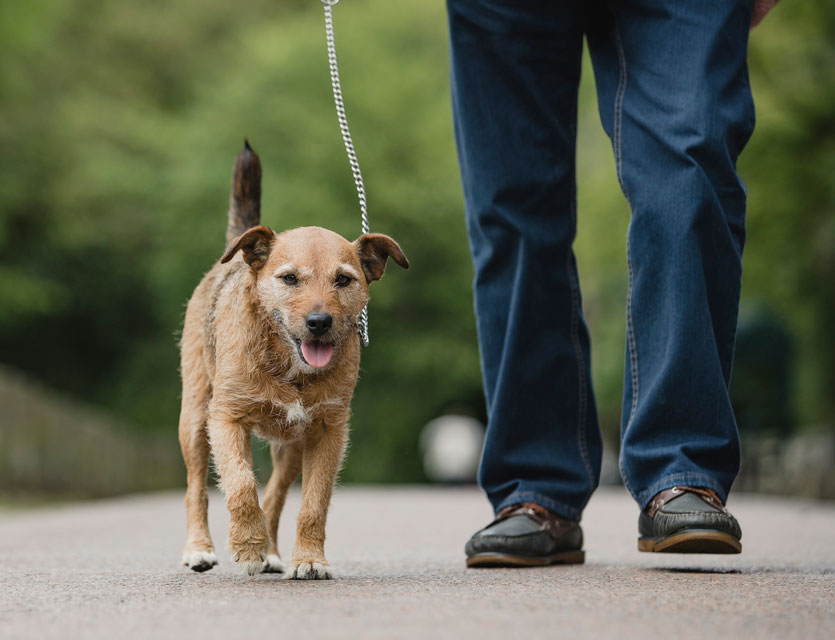Fabulous Tips for Walking Your Dog

Everyone knows that dogs love to go for walks. Chances are that when you get out your dog's leash, she goes crazy with excitement.
Walking your dog daily is good for physical health, mental health, and helps you bond with your dog. It also promotes confidence and good socialization in your dog because you're likely to come upon lots of varying situations, people, and other dogs during your forays.
Here are a few tips to make your dog-walking trips safer and more pleasant for both you and your dog.
Don't Use a Retractable Leash
Retractable leashes are popular with dog owners because it allows them to give their dog plenty of lead, so they can explore. However, retractable leashes are dangerous and dog owners should avoid using them.
A retractable leash consists of a long cord attached to a spring-loaded mechanism in the handle. The reasons they're dangerous are:
- The cord can cause serious injury or amputation to a person's hand or digits.
- The cord can get wrapped around objects, people, or the dog herself, all of which can cause serious injury to humans and pets.
- When your dog is at the end of the retractable cord that's let out all the way, you have virtually no control over her.
- Dogs can run fast when the cord is let out all the way. When they hit the end, it's easy for them to pull the handle right out of an owner's hand. Alternatively, when they hit the end, they can be jerked back, resulting in neck injuries.
Learn more of the dangers here: "Retractable Leashes: Know the Risks."
Always keep ID on Your Dog and Consider a Microchip
Whenever you are out and about with your dog, the danger exists that she could somehow get away from you and escape. Always keep up-to-date visible ID on your dog's collar. Additionally, consider getting her microchipped. If you do, keep your contact information current with the microchip company. Having visible ID as well as a permanent microchip on your dog provides the best chance that she'll make it back home if she's lost.
Don't Approach Other Dogs or People without Permission
This rule is non-negotiable. Don't let your dog run up to people or other dogs without permission. It can scare people and other dogs, result in knock-over injuries, or cause dog fights.
Use Reflective Clothing or Harness
If you ever walk during the twilight or dark hours, both you and your dog should wear reflective clothing to maintain safety. You can also put a light on your dog's collar to help her be more visible.
Bring Lots of Water for Both of You
Water is a must when you and your dog are exercising, so be sure you always have some for both of you when you go for a walk.
Don't Leave Home without a Poop Bag
You should never let your dog poop and leave it there. Not only does it cause a mess if someone steps in it, but it also encourages the spread of viruses and parasites. Always bring something with you with which you can pick up your dog's waste and carry it to a proper trash receptacle. We recommend biodegradable bags.
Know Where Dogs Aren't Allowed
There are always places where dogs aren't allowed, and you should know where those spots are in your area. Don't take your dog to places where they aren't welcomed to avoid any problems and show respect for those rules.
Use Dog Booties to Protect Paw Pads
Your dog's paw pads are more vulnerable to the elements than you might think. Hot pavement can burn them, and chemicals like road salt and antifreeze can also injure them. Not only that, but when your dog walks through things like fertilizer, salt, and motor oil, they may ingest those toxic substances later when they get home and lick their feet clean. Make a habit of putting dog booties on your dog to protect her from all those things.
Learn more: "Paw Pad Protection for Dogs."
Always Bring Treats
There may be times during your walks when you need to get or keep your dog's attention on you. It's handy to have some yummy dog treats with you at all times, just in case. You can also use them to reinforce training during walks, including heel and look commands.
Allow Time for Sniffing
Part of why your dog loves to go for walks is all the exploration. There are wonderful sights, sounds, and especially, smells. Your dog can smell more than you could imagine, and sniffing gives them so much information.
Allow time for your dog to sniff during walks. Learn more: "You Have E-Mail; Your Dog Has P-Mail."
Also, try to vary your route often. That will help prevent boredom for both you and your dog.
You May Also Like These Articles:
How to Teach Your Dog the Look Command
Retractable Dog Leashes: Know the Risks
Disclaimer: This website is not intended to replace professional consultation, diagnosis, or treatment by a licensed veterinarian. If you require any veterinary related advice, contact your veterinarian promptly. Information at DogHealth.com is exclusively of a general reference nature. Do not disregard veterinary advice or delay treatment as a result of accessing information at this site. Just Answer is an external service not affiliated with DogHealth.com.


